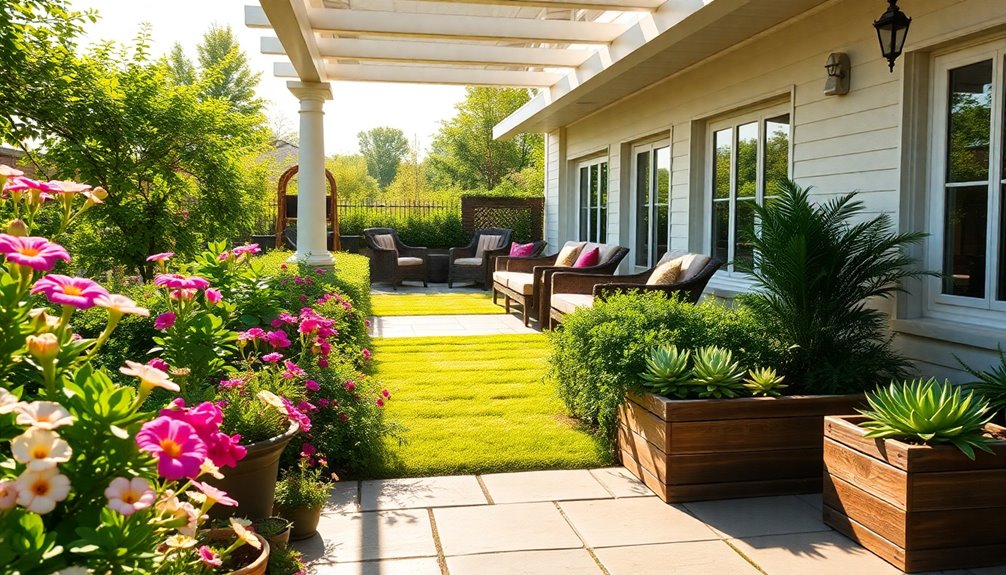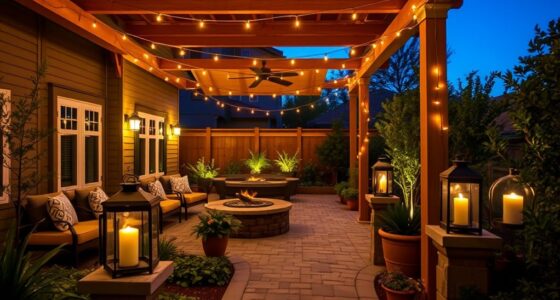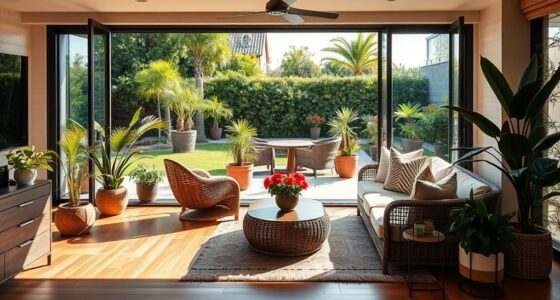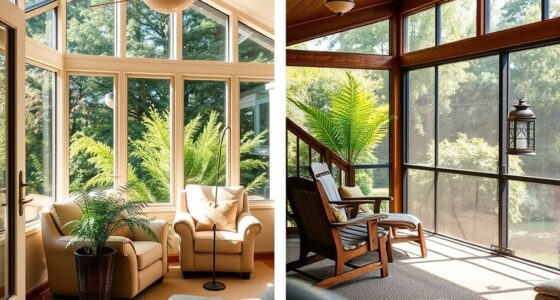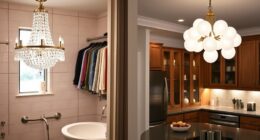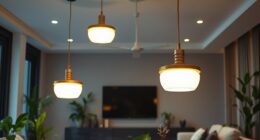To complement your home's interior, focus on enhancing indoor-outdoor flow using large windows and glass doors. Choose plants that reflect your interior colors and create depth with varied heights. Design pathways that mirror your home's layout for a cohesive look. Use thoughtful outdoor lighting and add containers for flexible planting options. Establish focal points in your landscape and echo architectural features with textures. There's so much more to explore in achieving that perfect harmony.
Key Takeaways
- Use large windows and glass doors to seamlessly connect indoor spaces with your garden, enhancing natural light and flow.
- Select a cohesive color scheme for outdoor plants that mirrors your home's interior aesthetic for a harmonious look.
- Incorporate decorative elements like trellises or sculptures in your garden to create visual interest that complements your home's design.
- Design outdoor living areas, such as patios, that reflect your indoor spaces for a unified living experience.
- Utilize indoor plants to enhance air quality and aesthetics, bridging the gap between your home and garden.
Enhancing Indoor-Outdoor Flow With Landscaping

When you want to create a harmonious connection between your indoor and outdoor spaces, consider incorporating elements that enhance that flow.
Opt for large windows and glass doors to invite natural light and open up your home to the garden. Using outdoor materials like brick or slate for your indoor flooring can create a cohesive aesthetic that ties your landscape design together.
Add potted plants and greenery inside to blur the lines between the two areas, promoting a vibrant atmosphere. Architectural features like trellises and wrought iron elements indoors can evoke the charm of your outdoor garden.
Finally, design pathways that lead from your interior spaces directly to outdoor areas, encouraging exploration and interaction with your beautiful garden. Additionally, incorporating natural elements in your decor promotes tranquility and enhances the overall ambiance.
Selecting Plants That Reflect Interior Colors

Creating a seamless connection between your indoor and outdoor spaces goes beyond architectural elements; it also includes the plants you choose.
Select plants that mirror your home's interior colors for a cohesive look. Here are some ideas to contemplate:
- Deep green foliage for a calming effect
- Vibrant reds and yellows to energize your space
- Flowering plants that bloom in hues matching your decor
- Pots and planters in shades that complement your color palette
Creating Depth With Layered Heights

To achieve a visually striking indoor garden, consider incorporating plants of varying heights.
Layered heights create a dynamic space, where taller plants serve as focal points while shorter ones provide depth. Use tall floor plants, medium-sized table plants, and low-lying ground covers or hanging plants to achieve this cascading effect.
Elevate smaller plants on stands or shelves to enhance the layered look without sacrificing floor space. Integrate architectural features like trellises or vertical planter boxes to boost verticality and interest in your landscape designs.
Additionally, strategically placing mirrors can reflect these heights, creating an illusion of greater depth and expanding your room's visual space.
Designing Pathways That Mirror Home Layout
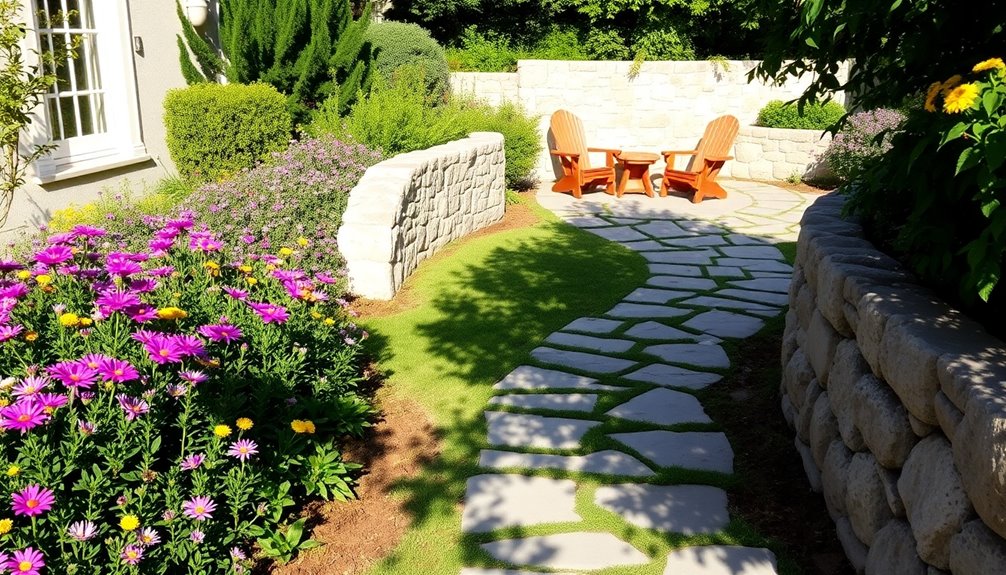
Designing pathways that align with your home's architectural lines enhances the connection between indoor and outdoor spaces.
By creating a cohesive flow, you boost the overall design and aesthetic appeal of your property.
- Incorporate bends and curves to mimic your interior layout, inviting exploration.
- Use materials like brick or slate that match your indoor flooring for a seamless connection.
- Verify pathways are 3 to 5 feet wide for comfort and accessibility.
- Add visual focal points, such as garden art or planters, to draw the eye and enhance your garden's charm.
These elements won't only create functional pathways but also enrich the relationship between your home and its outdoor surroundings.
Utilizing Thoughtful Lighting for Outdoor Spaces

When you think about outdoor lighting, consider how layered techniques can enhance your space.
By accenting key features like trees and pathways, you not only create a beautiful ambiance but also improve safety and security.
With the right lighting, your outdoor areas can shine both functionally and aesthetically at night.
Layered Lighting Techniques
While creating an inviting outdoor space, layered lighting techniques can transform your garden or patio into a versatile haven.
By combining ambient, task, and accent lighting, you'll enhance both functionality and curb appeal. Consider these elements:
- Ambient lighting: String lights or lanterns for overall illumination.
- Task lighting: Pathway lights or spotlights to guarantee safety and usability.
- Accent lighting: Uplighting on trees or architectural features to highlight focal points.
- Smart controls: Dimmers that let you adjust lighting levels for different occasions.
Incorporating energy-efficient LED fixtures not only reduces electricity consumption but also prolongs the lifespan of your lighting. Additionally, ensuring proper airflow around your outdoor lighting can improve its effectiveness and longevity.
With thoughtful layered lighting, your outdoor space will shine beautifully, day or night.
Accent Key Features
Accent lighting plays an essential role in highlighting key features of your outdoor space, creating an enchanting atmosphere that draws attention to architectural elements and natural beauty. By strategically placing lights, you can transform your landscape into a mesmerizing environment.
| Lighting Type | Purpose |
|---|---|
| Uplights on Trees | Highlight natural beauty |
| Pathway Lighting | Guide guests and enhance safety |
| Dimmable LED Fixtures | Adjust brightness for mood |
| Solar Lights | Emphasize garden art, reduce costs |
Utilizing these lighting techniques not only enhances aesthetic appeal but also fosters a seamless connection between your home's interior and exterior. Thoughtful lighting invites you and your guests to enjoy your outdoor spaces long into the evening. Additionally, consider incorporating soft lighting to create a warm and inviting ambiance similar to that found in romantic dining settings.
Safety and Security
Effective outdoor lighting not only enhances the beauty of your landscape but also plays an essential role in ensuring safety and security.
By illuminating pathways and entryways, you reduce the risk of trips and falls, especially in dark areas.
Here are some key lighting options to evaluate:
- Motion sensor lights that activate when movement is detected, deterring potential intruders.
- Solar-powered lights that save on electricity costs and keep your space lit during outages.
- Smart lighting systems allowing remote control and scheduling for added convenience and security.
- Strategic placement of lights to highlight landscape features while enhancing visibility.
Incorporating Hardscaping Elements

Incorporating hardscaping elements can transform your outdoor space into a functional and inviting area.
By choosing durable materials like stone and brick, you not only enhance visual interest but also guarantee your landscape stands the test of time. Additionally, using self-watering planters can further elevate your outdoor design by ensuring your plants receive consistent moisture with minimal maintenance.
Let's explore how to create defined areas that blend beauty with practicality in your yard.
Choosing Durable Materials
When you choose durable materials for your landscaping, you're not just enhancing the beauty of your outdoor space; you're also investing in its long-term functionality and resilience.
Incorporating hardscaping elements like brick, slate, and concrete can create a cohesive aesthetic that complements your home's interior design.
Consider these durable materials for your hardscaping:
- Concrete: Strong and versatile for pathways and patios.
- Stone: Natural beauty that withstands weather conditions.
- Brick: Timeless appeal and longevity for walkways.
- River rock: Effective for drainage and visual texture.
These choices not only reduce maintenance but also enhance the overall design and organization of your landscape, ensuring your outdoor area remains inviting and functional for years to come. Additionally, using energy-efficient designs in your landscaping can further promote sustainability and reduce your environmental impact.
Enhancing Visual Interest
To enhance visual interest in your garden, consider how hardscaping elements can define spaces and create structure. Incorporating features like patios, pathways, and retaining walls not only adds depth but also complements your home's architecture.
Choose durable materials such as stone, brick, or concrete to achieve a cohesive look that connects your indoor and outdoor environments. Decorative features like trellises and arbors can serve as focal points, drawing the eye and boosting curb appeal.
For a modern touch, integrate raised garden beds or planters made from hard materials. Finally, using gravel or decorative rocks in pathways and sitting areas adds texture and visual contrast while keeping maintenance low, enriching your landscape's overall design.
Creating Functional Spaces
Creating functional spaces in your garden hinges on the thoughtful integration of hardscaping elements. These features not only define areas for various activities but also enhance your home's exterior aesthetics.
Consider incorporating:
- Patios for outdoor dining and relaxation
- Walkways that guide visitors through your space
- Retaining walls to create tiered gardens
- Benches or fire pits for socializing and comfort
Using durable materials like brick or slate guarantees easy maintenance while complementing natural landscaping. Additionally, incorporating a large, rustic wooden dining table into your outdoor space can create an inviting area for gatherings.
Raised beds or planters can add visual interest and make gardening efficient. By strategically placing these hardscaping elements, you'll create inviting, functional spaces that seamlessly connect your indoor and outdoor living areas.
Adding Containers for Flexible Planting Options

Adding containers to your gardening routine offers a dynamic way to enhance your space and adapt to changing seasons.
With container gardening, you can easily rearrange plants to match your seasonal decor or personal style. Using a variety of container sizes and colors not only creates visual interest but also complements your home's interior aesthetic.
You can place containers both indoors and outdoors, providing a seamless shift between spaces and enriching your indoor-outdoor design concept.
Opt for lightweight materials like fiberglass or resin, which make moving your plants effortless.
Don't forget to incorporate drainage holes in your containers; this prevents water pooling and guarantees healthy root growth, keeping your plants vibrant and thriving.
Establishing Focal Points in the Landscape

Containers not only enhance your gardening options but also set the stage for more elaborate landscape designs.
To establish a focal point in your landscape, consider these landscaping tips:
- Sculptures or art pieces that draw the eye and spark conversation.
- Water features like fountains or ponds that create a soothing ambiance.
- Striking trees that stand tall and provide seasonal interest.
- Pathways leading to these focal points, guiding visitors through your garden.
Incorporate height variation by placing taller elements behind shorter ones, creating depth.
Use color repetition in your plant selections to emphasize the focal point.
Finally, don't underestimate the power of strategic lighting to highlight your chosen centerpiece, adding a dramatic flair to your landscape during the evening.
Using Textures to Echo Architectural Features
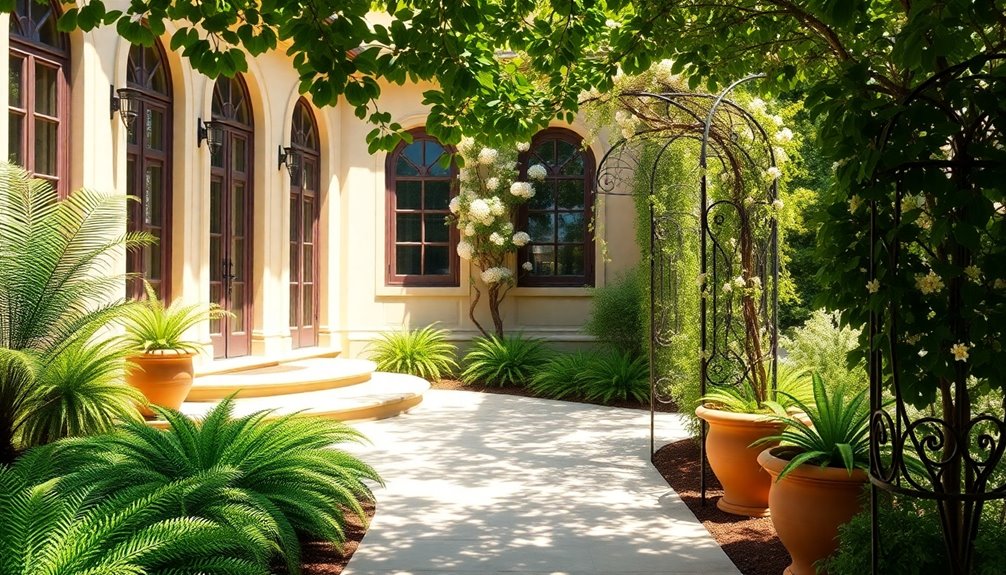
When you design your garden, think about how the materials and textures can reflect your home's architectural features.
Incorporating elements like brick or wrought iron not only enhances the visual appeal but also creates a harmonious connection between your indoor and outdoor spaces.
Material Harmony in Design
To create a seamless connection between your home and garden, consider how textures and materials can echo the architectural features of your residence.
Achieving material harmony enhances your landscape ideas and invites a cohesive aesthetic.
Here are some effective ways to integrate materials:
- Incorporate brick and slate in pathways and patios to reflect your home's exterior.
- Use wrought iron furniture and accents that mirror architectural elements.
- Select pots and urns made from concrete or terra cotta that align with your indoor decor.
- Implement trellises or arbors that echo the lines and shapes of your home.
Architectural Lines and Patterns
Architectural lines and patterns play an essential role in creating a unified look between your home and garden. To enhance your front yard, consider incorporating hardscaping elements like brick pathways or slate patios that echo your home's architectural features. Use raised garden beds with clean, geometric shapes alongside shrubs and flowers to reflect modern design.
| Design Element | Purpose |
|---|---|
| Brick Pathways | Echo architectural lines |
| Raised Garden Beds | Reflect structured lines |
| Trellises | Mimic home angles and shapes |
| Textured Plants | Create tactile experiences |
| Color Repetition | Reinforce architectural themes |
These strategies guarantee a cohesive shift from your home to your outdoor spaces, enhancing both curb appeal and visual interest. Additionally, incorporating non-toxic large houseplants can further tie indoor and outdoor aesthetics while ensuring a safe environment for pets.
Textural Contrast for Interest
Creating visual interest in your garden hinges on the effective use of textural contrast that mirrors your home's architectural features.
By thoughtfully selecting plants and materials, you can enhance both your outdoor space and your home's curb appeal. Here are some ideas to inspire you:
- Combine soft ferns with rugged succulents for striking textural contrast.
- Use brick or stone in hardscaping to reflect your home's facade.
- Incorporate smooth metal furniture alongside rough wood decor.
- Pair feathery ornamental grasses with structured shrubs and perennials for harmony.
This layered approach not only creates depth but also guarantees that your garden complements the architectural lines of your home, making for a cohesive and inviting environment. Additionally, consider utilizing natural materials to enhance the overall aesthetic, similar to the elements found in modern farmhouse design.
Maintaining a Cohesive Design Throughout the Home
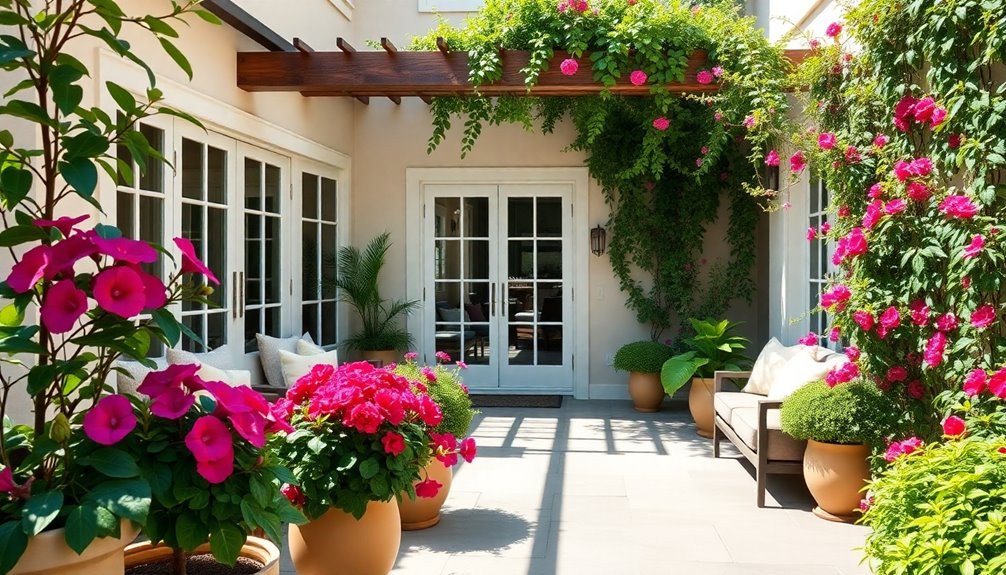
While you may not realize it, the design of your home can greatly benefit from a cohesive connection between your indoor and outdoor spaces.
Start by choosing indoor plants that echo the colors and textures of your garden design, creating a seamless shift. Use similar materials, like brick or slate, for both indoor flooring and outdoor pathways to enhance the cohesive aesthetic.
Incorporate garden-inspired furniture indoors, such as wrought iron tables and floral prints, to reflect your outdoor charm. Select wall art featuring botanical themes to visually unite your environments.
Finally, maintain a consistent color palette and design style, whether modern or rustic, throughout both your home design and outdoor areas to foster an inviting, harmonious atmosphere. Additionally, consider using sustainable materials that resonate with both your indoor and outdoor spaces for an eco-friendly approach.
Frequently Asked Questions
What Landscaping Adds Most Value to Home?
When considering what landscaping adds the most value to your home, focus on curb appeal and functionality.
Features like patios, outdoor kitchens, and well-maintained lawns can greatly boost your property's worth. Incorporating native plants not only attracts eco-conscious buyers but also lowers maintenance costs.
Strategically placed trees provide shade and reduce energy bills, enhancing both aesthetics and savings.
How to Frame Your House With Landscaping?
To frame your house with landscaping, start by planting large trees and shrubs that highlight its architectural features.
Use flowering plants and ornamental grasses along pathways to soften the edges and invite guests.
Vary heights and textures in your plant choices to create depth and draw attention to your home.
Regularly trim plants to keep them tidy, and consider adding mulch or decorative stones to unify the design and enhance the overall look.
What Is the First Rule of Landscaping?
The first rule of landscaping is to design with a clear understanding of your home's architecture.
You'll want to guarantee your landscape complements and enhances your house's overall style. Pay attention to proportions; larger homes benefit from bigger plants, while smaller homes look better with delicate plantings.
Incorporate symmetry and balance to create visual appeal, and use colors that match your exterior for a cohesive look.
This foundation sets the stage for a beautiful landscape.
What Are the Three Design Areas of a Residential Landscape?
The three design areas of a residential landscape are the front yard, backyard, and side yard.
In the front yard, you're focusing on curb appeal, creating inviting pathways and ornamental features.
Your backyard's all about recreation and relaxation, offering spaces for patios and gardens.
The side yard acts as a connecting area, providing utility and opportunities for additional planting or decorative elements.
Each space should harmonize with your home's architectural style for a cohesive look.
Conclusion
By thoughtfully integrating your landscaping with your home's interior, you can create a harmonious flow that enhances both spaces. Choose plants that echo your indoor colors, design pathways that reflect your home's layout, and establish focal points to draw the eye. Don't forget about lighting and textures that mirror architectural features. With these ideas in mind, you can maintain a cohesive design throughout, making your indoor and outdoor areas feel connected and inviting. Enjoy the transformation!
